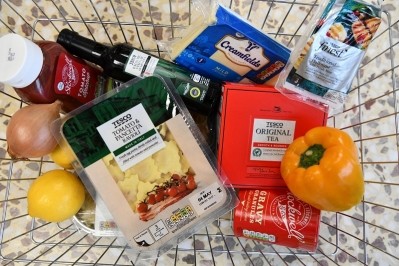‘The sector is behind over a quarter of total emissions’: Global investor group steps up pressure on industry over climate goals

An influential institutional investor group has stepped up pressure on the food and beverage industry over its failure to make progress on reaching climate change goals.
The Climate Action 100+ coalition, which consists of more than 615 investors with $55 trillion in assets, said the food and beverage sector accounts for about a third of global greenhouse gas emissions, with most coming from company supply chains.
The group said that scope 3 land-based emissions from the sector, or those not part of operations or under direct control, must be reduced by 85% in order to align with the International Energy Agency (IEA)’s Net Zero by 2050 report launched in May (proposals which were subsequently matched by the European Union).
Scope 3 is the magic number
The food and beverage sector is currently not on track to meet that target by some margin, warned Climate Action 100+. It said it sees little evidence of specific strategies to measure and reduce scope 3 emissions. Scope 1 (those a company makes directly) and scope 2 (associated with the purchase of electricity, steam, heat, or cooling) emissions, which make up about 17% of food and beverage sector emissions, must also be reduced as much as possible, it stated.
"Because the food and beverage sector is behind over a quarter of total greenhouse gas emissions, the companies have not only the responsibility but opportunity to reduce these emissions,” said Natalie Wasek, Shareholder Advocacy Manager at Seventh Generation Interfaith Coalition for Responsible Investing. “Investors have urged companies to adopt reduction targets, but without full sector and supply chain collaboration, the decarbonization transition has not been possible. Investors are looking for action plans to hold these companies accountable for reaching their targets. The Climate Action100+ initiative can help make this happen."
The group has released a set of expectations that it said lay out the necessary actions for the food and beverage sector to make progress towards achieving a net zero future in line with the goals of the Paris Agreement. Neither the individual companies nor the sector as a whole will be able to meet science-based emissions reduction targets without addressing supply chain upstream emissions from agriculture and land use change, it warned.
Eliminating deforestation, restoring previously cleared land, and employing agricultural practices that mitigate and sequester carbon alone all have the potential to mitigate more emissions than implementing renewable energy technologies across all sectors, the coalition said, adding that mitigating emissions in this sector presents companies with a significant challenge, in addition to enormous business and environmental opportunities.
Key expectations of companies include:
● Integrating supply chain climate action into corporate decision-making processes and procurement policies
● Incentivizing and supporting agricultural producers to reduce the climate impact of crop and livestock production and enhance agricultural carbon sequestration
● Aligning capital expenditures, product development, and R&D with a 1.5-degree scenario
● Transitioning to more efficient and renewable energy use and transportation across operations, distribution, and supply chains
● Improving processing, manufacturing, and packaging practices to reduce emissions and food loss
● Partnering with peers, suppliers, and policymakers to drive transformations across the sector
Investors ‘will want to see targets and details’
Mindy Lubber, CEO and president of Ceres, sustainable investor network, and Climate Action 100+ committee member said the group’s recommendations map out the supply chain actions that investors are looking to see from food and beverage companies in order to build credible climate action plans.
“By focusing on supply chains, these companies have a unique opportunity to collaborate on changing producing and sourcing practices to increase the ambition of emissions reduction for the whole sector,” she said. “Investors will need to see interim targets from companies and then details on how they will deliver these in the short and mid-term, so they can accurately assess how prepared they are for the net zero transition.”
Fellow Climate Action100+ member Fiona Reynolds, who is CEO of PRI, another network of investors supporting sustainable investments, added the food and beverage supply chain faces extensive challenges around addressing emissions.
“We’re encouraging companies in the sector, and investors working with those companies, to be aware of and take action on addressing emissions throughout these supply chains,” she said. “This includes committing to targets around reducing the impact of emissions related to agriculture and livestock, securing green transportation and distribution of products and sourcing sustainable packaging solutions, among others. We’re urging the sector to take note of the report released today and to work collaboratively to embed climate considerations into their operations.”
Supply chains are both responsible for and threatened by emissions
Julie Nash, director of food and forests at Ceres, told FoodNavigator the recent IPCC report (which concluded it is already too late to prevent the Earth’s average temperature from rising by more than 1.5C above pre-industrial levels by the middle of this century) make it clear that urgent action is needed now from food and beverage companies, both individually and across their supply chains.
“The IPCC report highlights the importance of food industry supply chains in addressing climate change: these supply chains are both responsible for a large swath of emissions and are particularly vulnerable to the impacts of those rising emissions,” she said. “One key finding is the importance of methane emissions as a short-term climate force. The food and agriculture sector is responsible for a large percentage of about half of methane emissions, and will need to include methane in its GHG reduction strategies in addition to carbon.”
The problem for food and beverage companies is that the biggest source of emissions comes from suppliers such as farms. Data is difficult to get, and inputs are hard to trace.
Nash claimed the food sector has a long way to go to measure, assess and reduce the impacts of its supply chain emissions. “Even as science-based greenhouse gas-reduction commitments have become a new standard for food companies, many of these commitments are limited,” she explained. They do not seek to measure or reduce the companies’ supply chain — or scope 3 (indirect) — emissions, especially those from agricultural production or those associated with land-use change, she claimed. “The majority of the sector’s emissions are embedded in the production of key agricultural commodities and fall under scope 3 emissions from the supply chain for companies that source, manufacture, distribute and sell agricultural or food products. Our recent analysis of 50 of the highest-emitting North American food companies found that most are not measuring and disclosing supply chain emissions, never mind including them in their targets.”
Will consumers accept higher costs?
But will companies’ customers be willing and able to pay more for environmentally healthy foods? British families, for example, face paying an extra £400 a year on foods, goods and travel to fund the cost of hitting the target of reaching zero emissions by 2050, according to the National Infrastructure Commission.
“Consumers have a role to play in driving demand for environmentally friendly foods,” said Nash. “But given that the food sector produces about a third of total greenhouse gas emissions worldwide, companies must achieve rapid decarbonisation in order to properly address this problem at scale. There are some interventions--such as ensuring that purchased raw materials don't contribute to deforestation--that can have a huge impact on GHG emissions but little impact on consumer prices. Investors can help guide these decisions via smart engagement strategies.”






























